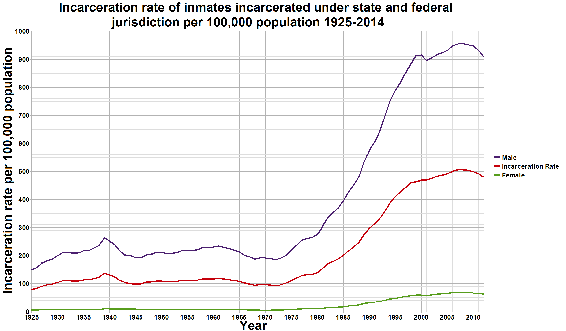5.2: State Level
- Page ID
- 16053
Prisons in the United States today are usually distinguished by custody levels. Super-maximum-security prisons are used to house the most violent and most escape prone inmates. These institutions are characterized by almost no inmate mobility within the facility, and fortress-like security measures. This type of facility is very expensive to build and operate. The first such prison was the notorious federal prison Alcatraz, built by the Federal Bureau of Prisons in 1934.
Maximum-security prisons are fortresses that house the most dangerous prisoners. Only 20% of the prisons in the United States are labeled as maximum security, but, because of their size, they hold about 33% of the inmates in custody. Because super-max prisons are relatively rare, maximum-security facilities hold the vast majority of America's dangerous convicts. These facilities are characterized by very low levels of inmate mobility, and extensive physical security measures.

Figure 5.1 Artist’s render of a supermax prison cell, Creative Commons Attribution-Share Alike 4.0 International
Tall walls and fences are common features, usually topped with razor wire. Watchtowers staffed by officers armed with rifles are common as well. Security lighting and video cameras are almost universal features.
States that use the death penalty usually place death row inside a maximum-security facility. These areas are usually segregated from the general population, and extra security measures are put in place. Death row is often regarded as a prison within a prison, often having different staff and procedures than the rest of the facility.
Medium-security prisons use a series of fences or walls to hold prisoners that, while still considered dangerous, are less of a threat than maximum-security prisoners. The physical security measures placed in these facilities is often as tight as for maximum-security institutions. The major difference is that medium-security facilities offer more inmate mobility, which translates into more treatment and work options. These institutions are most likely to engage inmates in industrial work, such as the printing of license plates for the State.
Minimum-security prisons are institutions that usually do not have walls and armed security. Prisoners housed in minimum-security prisons are considered to be nonviolent and represent a very small escape risk. Most of these institutions have far more programs for inmates, both inside the prison and outside in the community. Part of the difference in inmate rights and privileges stems from the fact that most inmates in minimum-security facilities are "short timers." In other words, they are scheduled for release soon. The idea is to make the often-problematic transition from prison to community go more smoothly. Inmates in these facilities may be assigned there initially, or they may have worked their way down from higher security levels through good behavior and an approaching release date.
Women are most often housed in women's prisons. These are distinguished along the same lines as male institutions. These institutions tend to be smaller than their male counterparts are, and there are far fewer of them. Women do not tend to be as violent as men are, and this is reflected in what they are incarcerated for.

Figure 5.2 Male v. Female Incarceration Rates in the U.S., Image is in the public domain.
Most female inmates are incarcerated for drug offenses. Inmate turnover tends to be higher in women's prisons because they tend to receive shorter sentences.
A few states operate coeducational prisons where both male and female inmates live together. The reason for this is that administrators believe that a more normal social environment will better facilitate eventual reintegration of both sexes into society. The fear of predation by adult male offenders keeps most facilities segregated by gender.
In the recent past, the dramatic growth in prison populations led to the emergence of private prisons. Private organizations claimed that they could own and operate prisons more efficiently than government agencies can. The Corrections Corporation of America is the largest commercial operator of jails and prisons in the United States. The popularity of the idea has waned in recent years, mostly due to legal liability issues and a failure to realize the huge savings promised by the private corporations.

